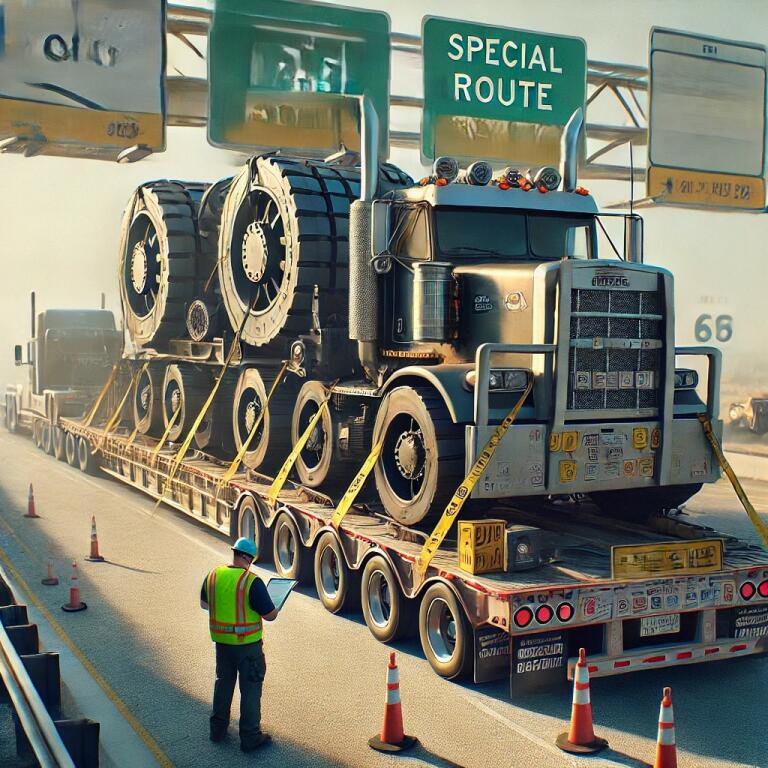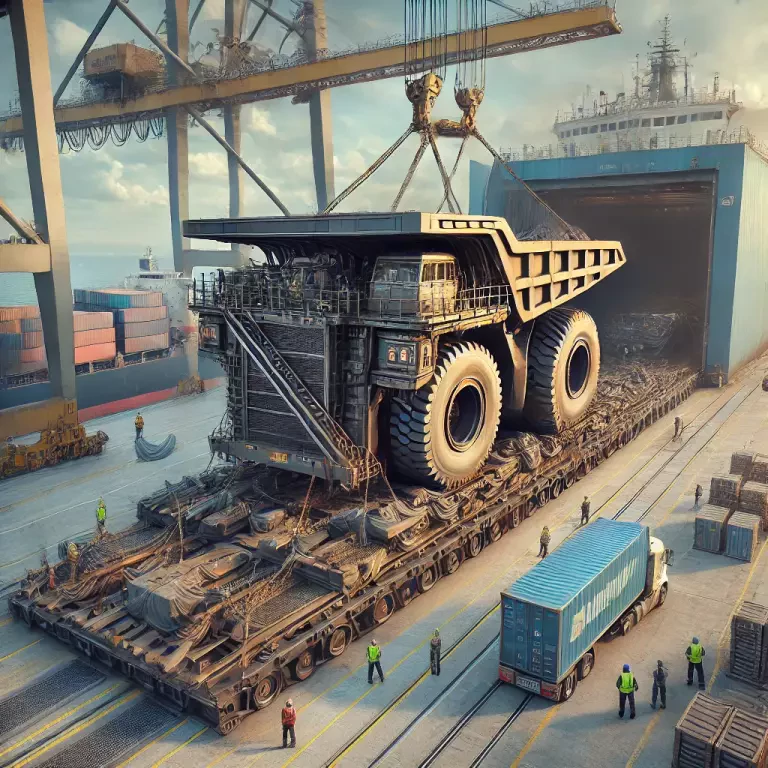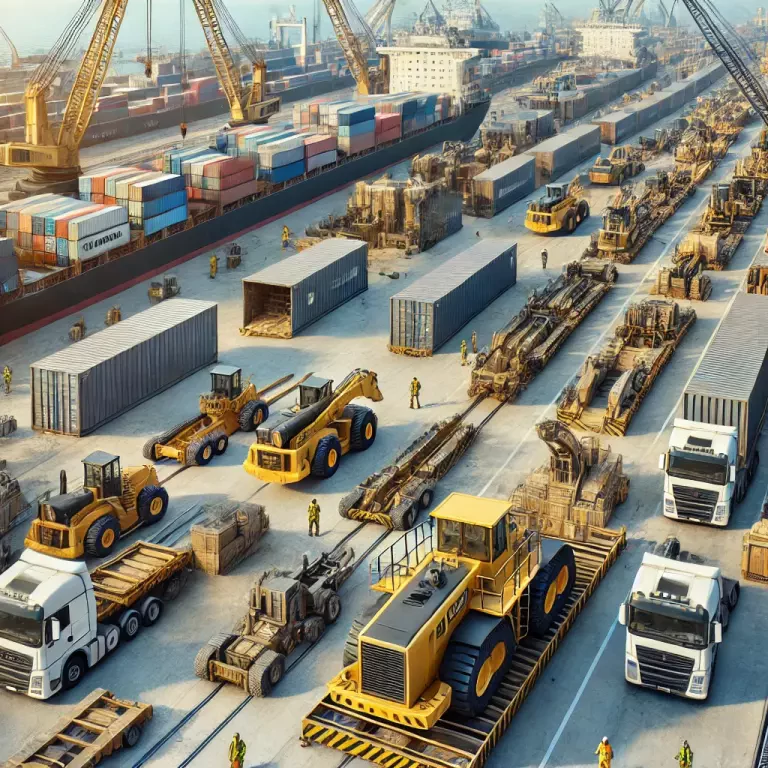
Shipping heavy equipment is a pivotal aspect of numerous industries, and understanding its significance can provide crucial insights into effective logistics management. As businesses continually expand their operations and require transportation for oversized machinery, shipping heavy equipment has become a necessity rather than an option.
To ensure smooth and lawful transportation, factors that affect shipping costs, necessary permits, and safety compliance must be considered. You should also consider your reasons for shipping heavy equipment, explore different shipping methods, and consider what's needed for a successful shipment.

Benefits of Shipping Heavy Equipment
Shipping heavy equipment can be a challenge, but it's necessary for companies in construction, agriculture, mining, and other industries. Here, we'll explore the advantages of shipping heavy machinery.
From using specialized trailers to enlisting professional heavy equipment transport services, we will consider why this practice is common and beneficial for businesses requiring the transportation of oversized loads.
Cost-effectiveness
The shipping method you choose can greatly impact the overall cost. Flatbed Trailers, specialized trailers, and flat rack containers are designed to handle oversized loads efficiently. By using these types of equipment, freight carriers are equipped to move heavy machinery at a lower cost than other methods, like disassembling the equipment or hiring additional manpower.
Shipping heavy equipment through a reputable shipping company often includes freight insurance, which adds financial protection against the risk of damage during transport. Furthermore, with the fluctuating fuel prices, companies benefit when they outsource to carriers specializing in heavy equipment shipments as they can consolidate loads to save space and fuel.
Time efficiency
Choosing the right type of transport vehicle such as Double Drop Trailers or flat rack containers, can minimize the time required to load and unload heavy equipment.
Moreover, shipping companies with expertise in handling heavy equipment understand the intricacies involved in the legal and logistical requirements, ensuring that heavy loads are delivered safely without delays caused by regulatory compliance issues.

Reducing the need for investment in transportation
By turning to heavy equipment transport companies, businesses can eliminate the large capital expenditure that would normally be required for the ownership and maintenance of large and specialized trailers to carry out heavy equipment shipping needs. This also removes the requirement for businesses to invest in personnel training to operate these complex trailers safely.
Additionally, the logistics around heavy equipment transport—such as obtaining the necessary permits for oversized loads or coordinating with local authorities along the route—can be intricate and time-consuming.
Utilizing the professional services of established freight carriers for heavy haul shipments frees the business from these burdens, allowing them to devote more resources to their core operational activities.
Shipping Methods for Heavy Equipment
When shipping heavy equipment, you must choose the correct method to ensure the items arrive safely, on time, and within a reasonable budget. Heavy equipment shipping generally involves a few common methods, each suited to different types of equipment and their specific transportation challenges.
Freight carriers offer these tailored services, which often include the securement of oversized loads, necessary permits for hauling, and navigation of the logistics involved in international and domestic shipping.
Container shipping
Container shipping is a common method for transporting heavy machinery that can fit within the standardized dimensions of shipping containers. The equipment is secured inside the container, protecting it from the elements and reducing the risk of damage during transit.
Containers come in various sizes, with 20-foot and 40-foot being the most common. Some heavy equipment might require disassembly before shipping to fit into a container.
This method integrates well with global logistics systems, offering the advantage of seamless intermodal transport—from a shipping vessel to a rail system or truck for final delivery.
Roll-on/Roll-off (RoRo)
Roll-on/roll-off shipping is designed explicitly for wheeled and track-based heavy equipment, such as dump trucks and bulldozers. Vehicles are driven onto the RoRo shipping vessel via built-in ramps, making it an efficient and fast loading/unloading process.
This method eliminates the need for crane lifts and reduces handling, thus minimizing the chance of damage. RoRo is often more cost-effective and quicker than other methods, though it is limited to port-to-port travel.
Flat rack transportation
Flat racks provide versatility in shipping oversized loads and heavy machinery that standard containers cannot accommodate. They have an open design with no sides or tops, allowing for the transportation of items over the height or width of a standard container. Heavy equipment is secured onto the flat rack, which can then be loaded onto a container ship or flatbed trailer.
This method is highly adaptable and suitable for heavy industrial machinery but may require additional protection or tarping to safeguard the machinery against weather during transit.

Permits for Heavy Machinery
Permits are legal documents that grant permission to move heavy machinery, and they must be obtained before transport. The types and requirements of permits can vary, with some common permits including:
- Overweight permits: Issued for loads exceeding the standard weight limits.
- Oversize permits: Required for equipment larger than the standard legal dimensions for height, width, or length.
- Trip permits: May be needed for shipping equipment through states or provinces where the carrier is not normally licensed.
- Specialized permits: These may be needed for equipment with unique requirements, such as hazardous materials.
Obtaining the correct permits requires detailed information about the heavy equipment, the proposed route, and the travel duration. Shippers should work with experienced heavy equipment transport services that can effectively navigate these requirements, mitigating the risk of encountering legal issues or incurring fines.
Ensuring Safety During Transport
Ensuring safety during heavy machinery transport requires meticulous attention to detail and a comprehensive understanding of the potential hazards.
Shipping equipment must be properly secured to mitigate the risk of damage. Flat rack containers or flatbed trailers offer a stable platform for heavy machines, whereas specialized trailers like double drop trailers might be employed for particularly tall or long items.
- Secure Load: Heavy equipment must be appropriately fastened with chains, straps, or other securement devices to prevent movement during transport.
- Vehicle Maintenance: Regular checks and maintenance of transport vehicles ensure they are in good condition and safe for carrying heavy loads.
- Training: Operators must be thoroughly trained in safe loading, unloading, and transport practices.
- Safety Gear: Transport crews should utilize appropriate safety gear, such as high-visibility clothing and hard hats.
- Emergency Preparedness: Plans should be in place to address any emergencies that may occur en route.

Final Thoughts on Shipping Heavy Equipment
Shipping heavy equipment is a significant undertaking due to its size, weight, and complexity. When considering how to transport such items, it is a good idea to engage with a reputable shipping company.
These companies are equipped with the right tools, such as flatbed trailers, specialized trailers, and flat rack containers, to handle heavy loads, including oversized equipment, safely.
A standard method for shipping oversized equipment is to use flat racks for very large items, ensuring a wide range of equipment types that can be accommodated. While choosing the most efficient shipping method, it is also crucial to consider the type of equipment, shipping costs, and routes. Freight insurance is a must, as it mitigates the risk of damage during transit.
Freight carriers may offer a variety of trailers, such as Double Drop or standard trailers, each designed to support the weight and dimensions of different heavy machines. Factors such as fuel prices and shipping vessel schedules can impact the cost and the delivery times.
Ultimately, heavy equipment transport services are indispensable for businesses involved in industries that require the movement of industrial machinery. The right shipping partner can ensure that heavy equipment shipments reach their destinations safely and on time.
Don’t take chances with your valuable equipment—choose A-1 Auto Transport for guaranteed safe delivery. Your perfect shipping solution is just a click away—get your free shipping quote now!






 Share on Facebook
Share on Facebook Share on LinkedIn
Share on LinkedIn Share on Twitter
Share on Twitter




 Google
Google  Instagram
Instagram  Trustpilot
Trustpilot 



